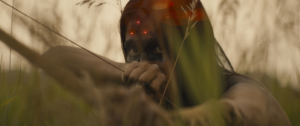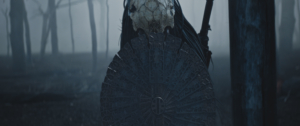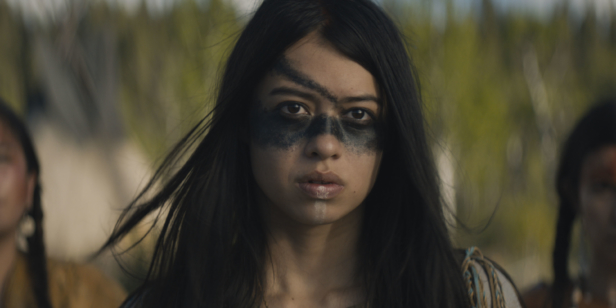It’s probably fair to say that the 1980s was a bustling time for action movies and, in turn, action stars. We had Tom Cruise playing topless vollyball in Top Gun in 1986, Bruce Willis saving Christmas in Die Hard in 1988, Harrison Ford battling Nazis in Indiana Jones and Raiders of the Lost Ark and plenty more (Sigourney Weaver in Aliens, Mel Gibson and Danny Glover Lethal Weapon – we’ll come back to Glover later – Eddie Murphy in Beverly Hills Cop, Kurt Russell in Escape From New York, the list goes on).
However, one of the busiest action stars of that decade was Arnold Schwarzenegger. Let’s have a quick action run-down shall we? Conan the Barbarian in 1982, Conan the Destroyer in 1984, The Terminator that same year, Red Sonja in 1985, Commando also in 1985, Raw Deal in 1986, The Running Man in 1987 and, erm, Twins? Okay maybe not Twins but that’s a hella list of iconic action movies and some eagle-eyed readers out there may have noticed one giant omission: Predator.
Yes, the 1987 classic has more quotable lines than you can shake a pop culture quiz book at and it immediately captured audiences upon its release, heading straight to number one at the US box office on its opening weekend.
Telling the story of an elite paramilitary rescue team (lead by Schwarzenegger’s Dutch) on a mission to save hostages in guerrilla-held territory in a Central American rainforest who encounter a skilled, technologically advanced alien who hunts them down, the movie fused sci-fi and action into a boiling pot of box office gold. It also spawned a huge franchise – Predator 2 came three years later starring Danny Glover as Mike Harrigan (we said we’d mention him again), followed by Predators in 2010 and The Predator in 2018. There has also been numerous spin-offs like the genre mash-up Alien Vs Predator in 2004 and Aliens vs. Predator: Requiem in 2007.
Now, adding to that franchise is brand new prequal, Prey, set 300 years ago in the Comanche Nation and telling the story of a young woman, Naru. When an evolved alien predator sets its sights on her people, the two have a vicious and terrifying showdown that blurs the line between hunter and prey.
It’s not the first time the idea of the predator species having visited Earth long before Dutch has been explored and in Prey, that idea has been taken further, with humanity battling a technologically advanced creature long before automatic weapons. Though, according to Amber Midhunter who plays Naru, this doesn’t mean that the people going up against the predator are in any way at a disadvantage: “It’s funny, I hear people always talk about the matchup and how unequal the matchup is. But Comanche people were known for being incredible warriors and incredible hunters. So, when I think of this, I think of the time period and the people and this character as being far beyond capable. I think of it as ‘oh, he chose a good opponent’ not ‘how are they going to measure up?’ because that’s the truth of the accuracy of the history.
“Native people and specifically Comanche people were incredible warriors, hunters, innovators with weapons. And oftentimes with Predator films, it doesn’t always come down to brute force…”

The predator has certainly met his match coming up against Comanche people and especially Naru who has been raised in the shadow of some of the most legendary hunters who roam the Great Plains. Not only does that lead to an epic showdown between the two, but it meant that Midthunder had to physically prepare for the grueling role: “We had a four-week boot camp that me, Dakota [Beavers, who plays Taabe] and the rest of the boys were at,” she tells us. “We had weapons training and we worked with the stunt team and a personal trainer. We were there every morning until the evening just trying to get as prepared as possible for all the things we would face. We also developed a sign language for the film that’s based on real Comanche sign language.”
Indeed, it was incredibly important for the filmmakers to be as true to the time period as possible and ensured plenty of research was done ahead of filming: “We wanted it to be as authentic as possible,” producer Jhane Myers nods when we ask her about the research. “Since it’s taking place in the 1700s we had Comanche people in all aspects and then where there weren’t Comanche people available, we had native people.
“The American sign language, ASL, was started from a trade sign language that the Comanches had developed, so our person that was at their boot camp was trained in tactical sign language. So we combined the two to make a hybrid sign language so Amber could communicate with the other hunters.”
The time period isn’t the only element that sets this Predator film apart, Prey’s female protagonis certainly has it stepping away from its male-heavy predecessors and that male-heavy action hero list we had earlier: “I think that the opportunity to have a female action hero, but specifically an indigenous female action hero, gives you a different set of colours to paint with when it comes to motivations,” Midthunder says. “I feel like you often see heroes go through this hero’s journey and this one has all the things that you love about that.
“I often hear Dan [Trachtenberg, director] talk about this as an underdog story. But also, you see it from a different perspective, whether that’s the time period or the culture and how Comanche people and native people regard things like community and family or just down to an individual level of how she feels about that. She’s very focused and determined and somebody who the more you tell her ‘no’ wants to prove ‘yes’. What makes her relatable is she’s very strong in her ideas but also has private moments of doubt. Whether you’re facing an alien hunter, or just something normal and everyday, I think that’s what people can relate to.”
“[This is] a protagonist that is far more relatable than what we’ve seen before,” Trachtenberg adds. “I think Arnold represents the wish fulfillment of ‘80s action films. We all look to Arnold and Sly and Van Damme as men with a set of skills that we could never have, or a set of physical attributes that we can never have, and embrace and enjoy the wish fulfillment of watching them kick butt.
“But Naru represents the other side of that coin. A character who was not born with all of those gifts, who has to work hard to achieve what she wants. I find that a much more rewarding experience and a much more intense one. So I think this entry is a little bit scarier than the others have been. Hopefully more intense and hopefully a little more beautiful as well.”
Trachtenberg is no stranger to making very good movies from an established property (he directed 2016’s surprise hit 10 Cloverfield Lane) and clearly understands the legacy of the Predator franchise. For his part, he believes that the enduring franchise is down to its genre mash-up and the creature itself: “I think it’s two things,” he nods. “One is the genre-bending of it certainly captured our imaginations in ‘87. And it’s also the creature design. That really is the thing that has stood the test of time.”
“Everyone loves the predator,” Myers agrees. “It’s the predator! Everybody’s excited to see what scenario he’s going to be in. How does he look? Is he going to be tall, short? Even when I watched some of the other Predators I liked how they had the smaller ones and they varied in size. That was kind of cool. The predator is beloved.”
“It’s true,” Midthunder adds. ”I think the anthology aspect of the series is what affords it the opportunity to have so many lives. Every time there’s a new movie, the characters change, the setting changes, the time period changes. So there’s so much creative freedom as well as maintaining the same character of the predator that everybody loves and then you even get to have fun changes like that. Like, our predator has a different look and different weapons and a new design. So while staying loyal, there’s a lot of ability for variety.”

So there are plenty of new predator elements to look out for in Prey, but are there any cheeky easter eggs that Predator fans should also look out for? We’re looking to you Dan… “Sure!” he nods. “I mean, there are definitely lines. There are some lines that Taabe [Dakota Beavers] says and there are some lines that Naru says that are direct references. There’s a way a character is cut that is probably the deepest cut literally and figuratively, that the movie makes. And of course, there’s mud and all sorts of other stuff. So there’s a lot of easter eggs depending on what level of fan you are in the franchise…”
We guess Predator mega-fans need to keep an eye out while watching Prey, but that doesn’t mean you have to be a die-hard fan to enjoy this new addition to the franchise either: “It is in the franchise, but it’s made as a standalone,” Myers tells us. “You can watch this without watching any previous Predators and you would still get it and then for the Predator fans, it’s just another instalment.”
We’re pretty sure it’s not just those one-liners (“I ain’t got time to bleed”) or those action shots or Mr Schwarzenegger himself that’s ensured the Predator franchise has endured. But rather it’s all of those elements combined, alongside a genuinely clever story and a big dollop of the entertainment factor. It’s encouraging, then, that the filmmakers behind its latest addition hope to give you exactly the same.
“If you come purely to be entertained, obviously, that option is available,” Midthunder says. “You can go into it and just watch a lot of action and be very entertained and excited. I [also] think there are a lot of deeper concepts. Whether that’s about women as heroes or indigenous people or being educated about the time period and what life was like for Comanches at that time.”
“I think it’s important when you have a film that you entertain, and then you educate, with,” Myers adds. “By educating people then you empower Native people, because rarely is native history barely touched upon in any history class.
“So I think that if we can teach it through sci-fi, that’s pretty cool.”
We think so too! Prey is out on Disney+ on 5 August.



